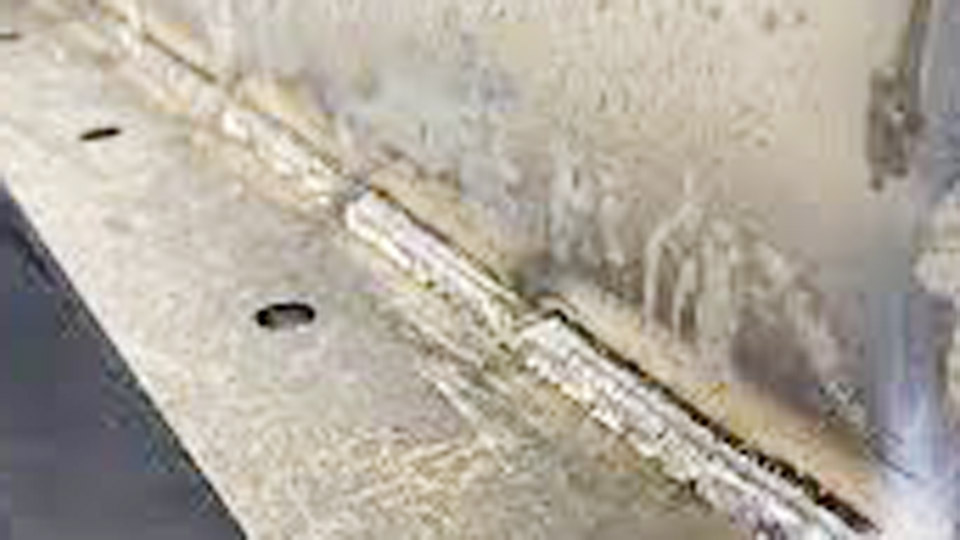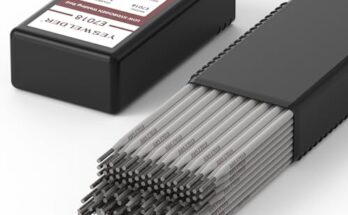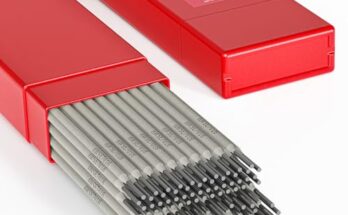When I first tackled a project that involved welding galvanized steel to mild steel, I thought, “How hard could it be?” Well, I quickly found out it’s not just a normal weld. Galvanized steel has its own set of rules because of that protective zinc coating.

Photo by reddit
If you’re sitting here, wondering exactly how to do it safely and correctly, you’re in the right place. I’ll walk you through everything — from preparation to finishing — just like I would if we were working side by side in the shop.
What Is Galvanized Steel and Why Is It Tricky to Weld?
Before we even strike an arc, it’s good to understand what galvanized steel really is.
Galvanized steel is just regular steel that’s coated with a thin layer of zinc to protect it from rust and corrosion. It’s fantastic for outdoor projects like fences, roofing, and trailers.
Then you weld galvanized steel, the zinc coating melts long before the steel itself does. This creates toxic fumes that are dangerous to breathe. Plus, it messes with your weld quality if you’re not prepared.
That’s why welding galvanized to mild steel needs a little extra care compared to welding plain steel to plain steel.
Tools and Safety Equipment You’ll Need
Welding galvanized materials demands more than just your helmet and gloves. Here’s what you should gather before starting:
| Equipment | Purpose |
|---|---|
| Welding Helmet with Respirator | Protects eyes and lungs from toxic zinc fumes |
| Protective Gloves and Jacket | Shields skin from burns and sparks |
| Angle Grinder or Wire Brush | Removes zinc coating around the weld zone |
| Welding Machine (MIG, Stick, or TIG) | Your choice, but MIG is the most common |
| Ventilation System or Fan | Helps disperse fumes |
| Galvanized Steel and Mild Steel Pieces | The materials you’ll weld together |
Always, and I mean always, put safety first. Zinc fumes are no joke. Long exposure can lead to serious lung issues.
Preparing the Steel for Welding
One thing I’ve learned the hard way: the prep work is just as important as the welding itself when it comes to galvanized steel.
Here’s how I prepare my pieces:
Clean the Area
Use an angle grinder, wire wheel, or even a chemical remover to strip off the zinc coating at least 1 to 2 inches away from the area you plan to weld.
Why? Because if the zinc is left on:
- You’ll breathe harmful fumes.
- Your weld will become porous and weak.
- You’ll risk poor fusion between metals.
Check the Fit-Up
Make sure the galvanized and mild steel pieces fit together tightly. Gaps can cause more fumes and make it harder to get a clean weld.
Ventilate Your Workspace
Whether you’re in a shop or your garage, make sure there’s a fan pulling fumes away from you, not just blowing them around. If you have access to a fume extractor, even better.
Choosing the Right Welding Method
You can weld galvanized to mild steel using MIG, Stick (SMAW), or TIG. Each has its pros and cons.
| Welding Method | Pros | Cons |
|---|---|---|
| MIG Welding | Fast, easier for beginners, clean finish | Equipment can be costly |
| Stick Welding | Good for outdoors, penetrates thicker metal | More spatter, rougher appearance |
| TIG Welding | Precise, clean welds, best control | Slower, needs very clean material |
I reach for MIG most of the time because it’s quick and versatile, especially for medium-sized projects.
How to Weld Galvanized Steel to Mild Steel Step-by-Step
Alright, now let’s get into the real action. Here’s the process I follow:
Step 1: Set Up Your Work Area
Make sure your welding table is clean and stable. Set up fans or ventilation to pull fumes away from your breathing zone. Put on your full protective gear, including a respirator or helmet with a built-in PAPR system.
Step 2: Clean Both Metals
Even though mild steel doesn’t have a coating, it’s good practice to clean it with a wire brush or grinder. Remove rust, oil, or dirt. Cleanliness makes better welds.
Step 3: Tack Weld
Tack your pieces together in a few spots to hold everything in place. This prevents movement when you start your full weld.
Step 4: Choose the Right Settings
If you’re MIG welding, select a slightly higher voltage and wire feed speed than you would for plain mild steel. The zinc layer (even after grinding) can still affect penetration.
For stick welding, use a 6011 or 7018 rod, which are great for dealing with coatings.
Step 5: Weld in Short Sections
Because galvanized metal can still emit fumes and cause weld defects, I like to weld in short bursts. Weld a few inches, stop, clean up if needed, then continue.
Move steadily but don’t rush. Watch the puddle carefully to make sure you’re burning into the steel, not just floating on top.
Step 6: Clean Between Passes
If you’re doing multiple passes, use a wire brush or grinder between passes to clean any slag or contamination.
Step 7: Cool Down and Inspect
Once you’re done, let the piece cool slowly. Inspect your welds for any porosity, undercut, or weak spots.
If needed, do some touch-up passes.
Special Tips for Better Results
Over the years, I’ve picked up a few extra tricks:
- Use anti-spatter spray around your weld area. It keeps your project cleaner and saves grinding time later.
- Preheat thicker metals slightly with a torch. This helps reduce cracking.
- Push, don’t pull your MIG weld. Pushing allows better gas coverage and cleaner welds.
- Be prepared for more grinding. Welding galvanized often leads to messy spots that need cleanup.
- Stay aware of fumes at all times. Even after cleaning, trace amounts of zinc can still cause issues.
Problems and How to Solve Them
You might run into a few hurdles, especially early on. Here’s what to look out for:
| Problem | Cause | Solution |
|---|---|---|
| Porosity (tiny holes) | Zinc vapor trapped in weld | Clean better before welding, use higher voltage |
| Weak Welds | Poor fusion due to coating | Grind coating thoroughly, slower travel speed |
| Excessive Spatter | Wrong settings or dirty metal | Fine-tune machine settings, clean surfaces |
| Fume Sickness (metal fume fever) | Inhalation of zinc fumes | Always ventilate, wear a respirator |
Don’t beat yourself up if you hit a few bumps. Welding galvanized is just plain tougher than welding clean steel.
Post-Weld Finishing
After welding galvanized steel to mild steel, you have a few options:
- Grind smooth if appearance matters. This also helps remove any leftover zinc near the weld.
- Apply a cold galvanizing spray to recoat the bare areas. This restores corrosion protection.
- Prime and paint if the piece will be used outdoors.
Skipping these steps could leave your project vulnerable to rust, so it’s worth the little extra time.
Is Welding Galvanized Steel Dangerous?
Yes, it can be—if you don’t take proper precautions.
Inhaling zinc oxide fumes can cause metal fume fever, which feels a lot like the flu. Symptoms can include:
- Fever
- Chills
- Nausea
- Chest tightness
- Fatigue
That’s why ventilation, respirators, and careful work practices are absolutely essential.
If you ever start feeling sick while welding galvanized, stop immediately, get fresh air, and seek medical help if symptoms get worse.
Advantages of Welding Galvanized Steel to Mild Steel
Even with all these challenges, there are real benefits:
- Cost-effective: Galvanized steel is cheaper than stainless steel and still offers good corrosion resistance.
- Durability: A properly welded and finished joint can last years, even outdoors.
- Strength: When done right, the weld is just as strong as traditional mild steel joints.
Conclusion
Welding galvanized steel to mild steel isn’t the easiest job, but it’s completely doable with the right preparation, equipment, and patience.
The key steps are simple:
- Strip the zinc coating.
- Use proper safety gear.
- Choose the right welding method.
- Control your heat and movement.
- Finish the project with a protective coating.
If you treat galvanized steel with the respect it demands, you’ll end up with solid, professional-looking welds that can stand up to the elements.
FAQs About Welding Galvanized Steel to Mild Steel
Can you weld galvanized steel without removing the coating?
It’s possible but not recommended. Removing the zinc coating ensures better weld quality and reduces toxic fumes.
What is the best welding method for galvanized steel to mild steel?
MIG welding is often the easiest and cleanest method, but stick and TIG can also be used depending on the project.
Is it safe to weld galvanized steel indoors?
It’s safer to weld outdoors or in a well-ventilated shop with fume extraction. Always wear a respirator when working indoors.
Can you weld through galvanizing with a stick welder?
Yes, using a 6011 or 7018 rod, but it’s still better to remove the coating before welding.
What should you do after welding galvanized steel?
Apply a cold galvanizing spray or paint over the bare steel to restore corrosion protection.







